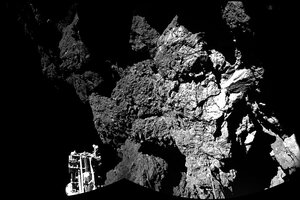Rosetta's Philae lander races against time as battery life dwindles
Philae appears to have landed in the shadow of a rock, rendering its solar panels at least temporarily useless in terms of recharging the lander's batteries.

The combination photo of different images taken with the CIVA camera system released by the European Space Agency ESA on Thursday shows Rosetta’s lander Philae as it is safely on the surface of Comet 67P/Churyumov-Gerasimenko, as these first CIVA images confirm. One of the lander’s three feet can be seen in the foreground. Philae became the first spacecraft to land on a comet when it touched down Wednesday on the comet, 67P/Churyumov-Gerasimenko.
Philae/Rosetta/European Space Agency/AP
The European Space Agency's comet-lander Philae is quickly draining its batteries, leaving the scientists and mission planners anxious about whether they will retrieve all of the data the 220-pound craft has gathered since it bounced to a landing on comet 67P/Churyumov-Gerasimenko on Wednesday.
The clearest indication of the batteries' status will come overnight tonight, when Philae is expected to phone home via its mother ship, Rosetta, which is orbiting the comet. Radio silence from the lander tonight would signal that the batteries have drained.
Rosetta aimed the lander at a broad bald spot atop the smallest lobe of the comet, which has the profile of a rubber ducky. That location would have provided plenty of sunlight to allow the craft's solar panels, which are built into Philae's sides, to keep the batteries topped off. But the two harpoons that were to have anchored the craft to the silt-covered surface failed to deploy on touchdown, leaving Philae to bounce twice before settling onto a spot that is mostly in the shade of surrounding rock formations.
The Rosetta-Philae team has yet to find the lander on the surface, but the craft has returned images from the surface as well as data from some of its science instruments.
So far, every instrument had been given a chance to make measurements, said Valentina Lommatsch, a member of the lander team at Philae's mission control center in Cologne, Germany, during a briefing today.
In some cases, however, it was unclear if some instruments were successfully deployed. Rosetta had moved into a portion of its orbit that prevents the two crafts from communicating.
“Cross your fingers, or press your thumbs if you're German, that perhaps we'll hear something from the lander again,” she said, holding out hope that even if the batteries have drained by tonight, the comet's travel toward the sun might bring it close enough to allow solar panels to deliver least a partial charge to the batteries and allow mission controllers to check Philae's status.
In order to save power, however, the science team had to make some agonizing choices, Ms. Lommatsch noted.
For instance, the craft carries two complementary instruments designed to in effect sniff the comet's coma – the envelope of dust and gas that surrounds the nucleus – and to analyze samples Philae's drill brings up from below the surface. The drill has been activated and had penetrated about 10 inches into the surface. The Philae team has no way of knowing yet how well the system has been performing, since Rosetta has yet to reach the point in its orbit where it can try to reestablish the communications link.
The science team opted to use only one of the two analyzers, the Cometary Sampling and Composition experiment dubbed COSAC, to tease out the composition of the drilling samples. It looks for a broader suite of compounds, including organics, and its measurements “are more complementary to the measurements we can do with the orbiter,” said Stephan Ulamec, the mission's lander manager.
It's hard to determine at this stage how much of the agenda in Philae's initial sequence of measurements will be achieved, Dr. Ulamec, said. Still, he posited that about 80 percent of what the researchers hoped to get has been received. The number would rise to around 90 percent if Philae's batteries have enough juice left in them to return the COSAC data.
Knowing that the craft landed in a heavily shadowed part of the comet's surface, mission planners have been trying to stretch the energy budget as best they could.
Analyses conducted overnight last night indicated that the experiments running today, including COSAC, would require about 80 watt-hours of power from the batteries, which had 100 watt-hours left in the tank, Lommatsch said.
Unfortunately, during its communications pass last night, Rosetta moved out of position before it could upload a command to the lander that would have shifted its status from standby during the loss-of-signal periods to low power, which would have helped reduce power consumption, she added.
It may be possible to gently rotate Philae's body, which sits atop a tripod-like set of legs. This would allow the team to move a larger solar array on one of the craft's sides into the light, providing a bit of extra power over the smaller array currently capturing sunlight.
Whatever the outcome, the team remains excited about it's comet landing, an historic first, as well as the science return Philae is delivering.
“This mission is fantastic,” said Andrea Accomazzo, Rosetta's flight-operations director. “Let's look at things we have done, what we have achieved. This is unique and will be unique forever.”

